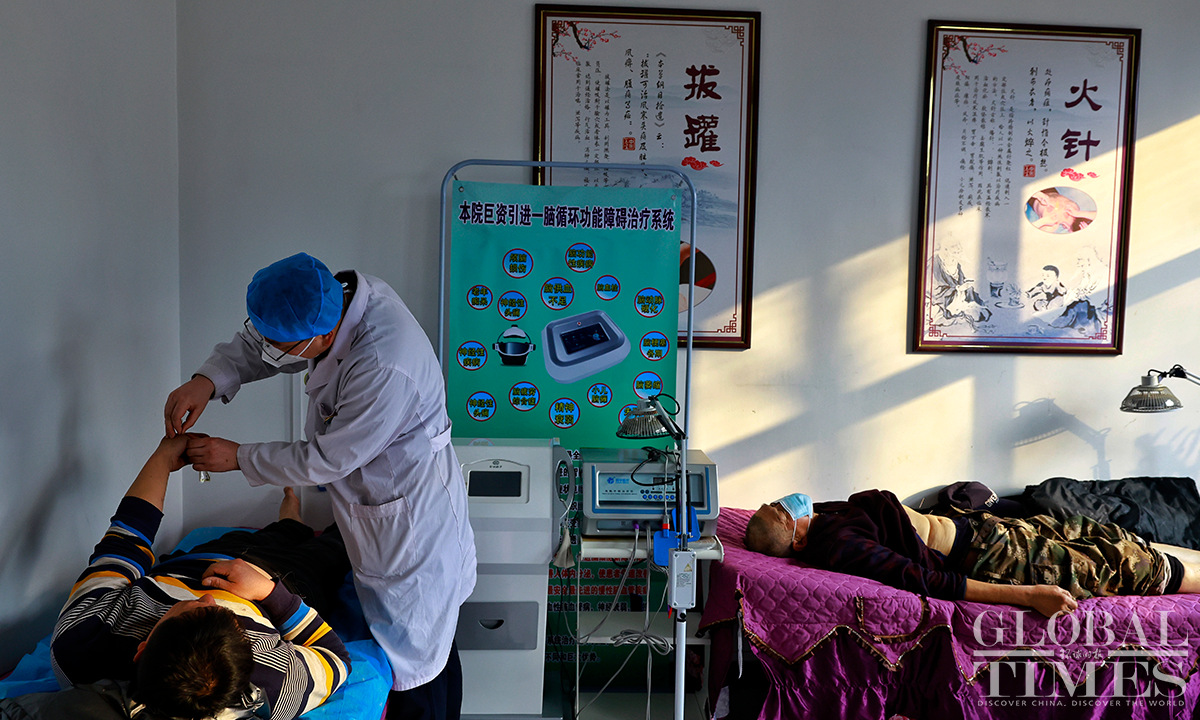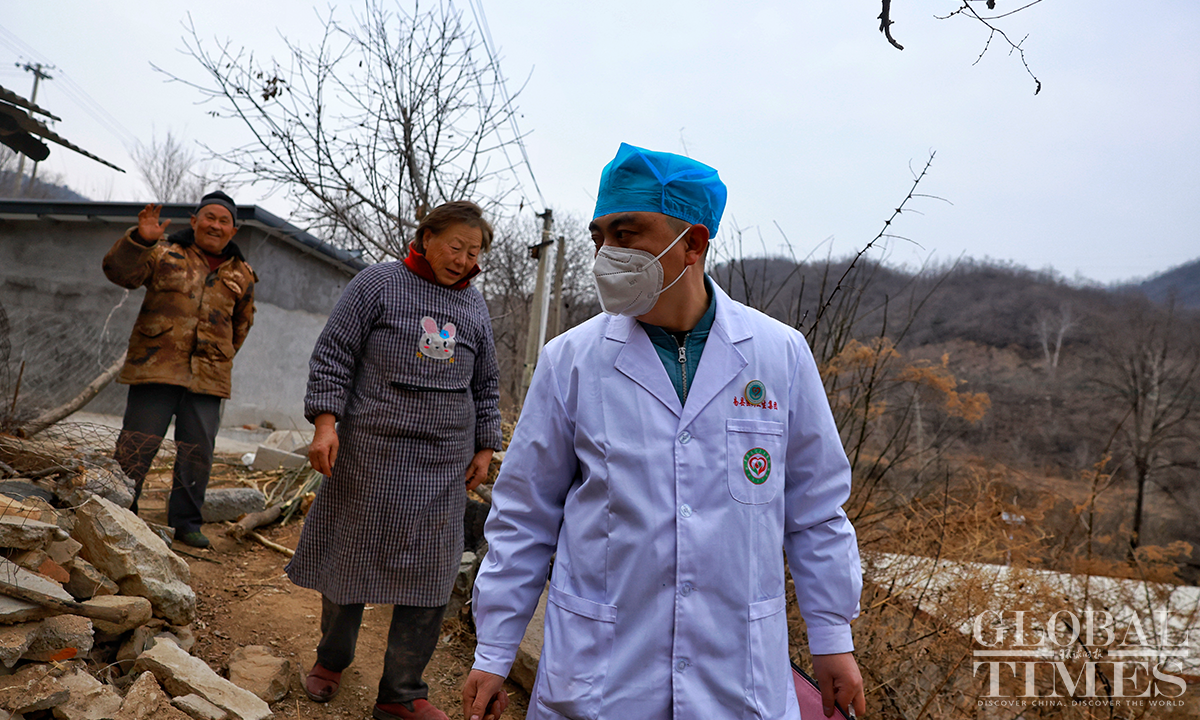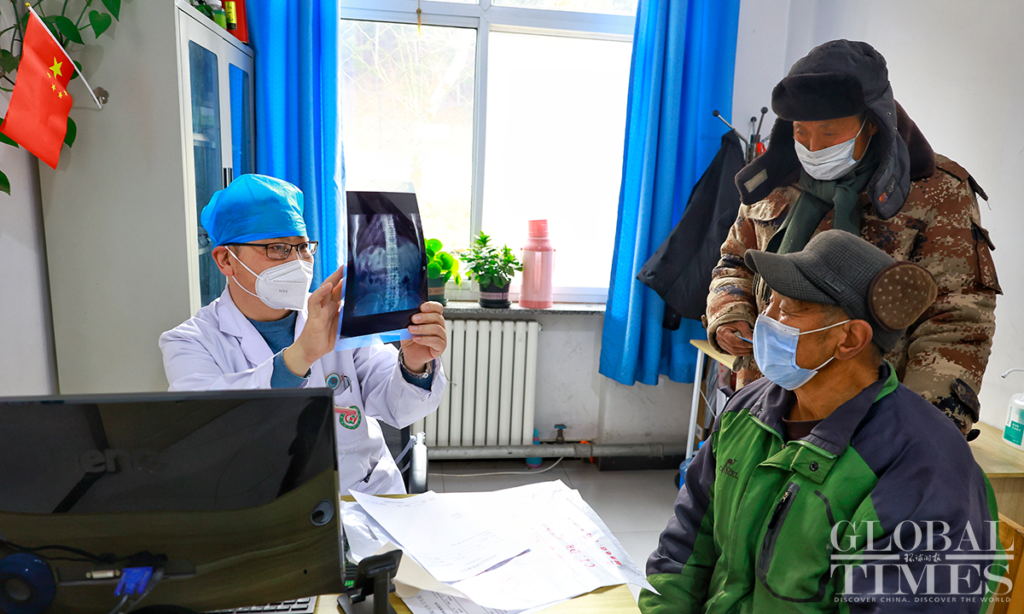Are China’s vast rural areas ready to cope with the COVID contagion in the exit wave?
This question has been frequently asked since China’s major change in COVID response strategy and the ongoing Spring Festival travel rush added to those concerns, as the mass migration is not only imbued with the joy of family reunion, but also carries risks of shocks to China’s relatively weak rural medical system.
One month into the implementation of the “new 10 measures,” Global Times reporters found the first batch of villages and counties to adopt the policy relaxation have withstood the first wave of infections and orderly preparations are being made in terms of medicines, equipment and personnel, for future waves including infections brought about by the Spring Festival travel rush, known as chunyun in Chinese, a period that lasts for 40 days.

Nanchengsi township hospital in Baoding, North China’s Hebei Province Photo: Li Hao/GT
1st hard battle
At the hospital in Yixian county of Baoding, North China’s Hebei Province, Tian Baili, an emergency room physician, told the Global Times that they have passed the hardest time – the outpatient department is seeing fewer visitors and 50 out of 650 beds are unoccupied.
Baoding was one of the earliest places to confront “an epidemic tsunami” after the relaxation of COVID-19 controls.
At the peak of the COVID wave, more than two-thirds of inpatients had COVID, but now it has dropped to about a third, Tian said.
The Global Times reporter learned from Caiyu county hospital in Daxing, Beijing that outpatient numbers have almost halved since January 5 from the New Year peak of 1,300 a day. During that time, 30 out of 100 CT images showed pneumonia symptoms so the hospital opened its wards to expand its capacity to offer drips and oxygen treatment.
The hospital coordinates with 43 village medical centers. Now it has sufficient fever and cough medicines, and 50 boxes of anti-viral drug Paxlovid. At two medical centers, the Global Times reporter saw very few patients in contrast to pharmacies full of medicines.
Many patients are coming to get medicine for pre-existing diseases, not COVID, Shi Chuang, the deputy director of the hospital, told the Global Times.

Zhang Xuefeng, a doctor in Nantai village, Yixian county, on January 11, 2023 walks in a mountain to visit villagers who got sick. Photo: Li Hao/GT
Data from Central China’s Henan Province suggests that with its large rural population, it had an overall infection rate of 89 percent, 89.1 percent in urban areas and 88.9 percent in rural areas, as of January 6.The Global Times learned from a medical center at Xihuaying township of Zhoukou in Henan that the number of new fever patients has dropped a lot since late December.
“The central hall was crowded with people struggling to get pills or get a drip. Now there are even empty seats,” a township resident surnamed Mu told the Global Times.
Tian Baili from Yixian county in Hebei recalled that during the hardest time, the shortage was acute because many doctors and nurses were infected and were too ill to work, and doctors of all different departments came to aid the emergency and respiratory departments.
A village doctor surnamed Zhao under Yixian county has treated more than 100 COVID patients since the policy change in December 2022, more than 30 were above 60 years old. All of them were given medicines and two were transferred to a county-level hospital or above.
Unlike some claims that rural China was unprepared for the coronavirus wave, Yixian county has allocated 5 million yuan ($740,000) to its public medical institutions to upgrade fever clinics and equipment. It allocated 3 million yuan to enhance it stocks of medicines, including fever pills and anti-virus medicines ahead of the national strategic change and the surge of infections.
The Global Times reporters shared the impression that the tiered medical care system played an important role in categorizing patients and giving treatment according to the need to minimize the strains on the system.
Village medical centers distribute pills for people with light symptoms and more serious patients go to township and county hospitals if they need drips or oxygen treatment. Some county hospitals have ICUs and respirators, and if they cannot handle the situation, the patient is transferred to better equipped hospitals in larger urban areas.
Tian’s hospital is part of a medical complex which includes a handful of hospitals, 27 township hospitals and 469 village medical centers. Medical resources are coordinated within the complex.
Training was held routinely to enhance grassroots medics’ skills, and the internet played a role in accurate diagnosis. “Patients can get a CT scan at township hospitals and some better-equipped village centers. Our doctors view the CT image via virtual link, taking the patient’s age and other health indicators into consideration, then decide whether the patient can stay for treatment or needs to be transferred,” Tian said.
China optimized its COVID response on December 7, 2022 with 10 prevention and control measures. The same day, China’s top COVID response coordination unit, the State Council’s joint prevention and control mechanism, issued a notice guiding both urban and rural areas, via the “medical complex” structure, to better implement the tiered diagnosis and treatment system.
Since then, the top coordination unit has issued at least five documents targeting rural epidemic control and the National Health Commission (NHC) held multiple meetings to assign related work.
Liang Wannian, head of the COVID-19 response expert panel under the NHC, said at a public health event on Wednesday that China’s infection peak is declining, but the medical system is still at a critical time in regard to the treatment of serious illnesses, the prevention and control of rural epidemics, and the protection of key populations.

Zhang Xuefeng, a doctor and villagers in Nantai village, Yixian county Photo: Li Hao/GT
New challenges
Different places confronted the infection peak at different times. An investigation by the Farmers’ Daily of 16 villages in 10 provinces and regions – Hunan, Sichuan, Jiangxi, Inner Mongolia, Zhejiang, Guizhou, Shandong, Gansu and Shaanxi – found 60 to 80 percent of the villagers have been infected.
The shortage of medicine has eased a lot as of Saturday.
Now, cities, towns and villages across the nation are gearing up for the Spring Festival travel rush which could cause another round of contagion.
Liang on Wednesday put forward three priorities for epidemic prevention in rural areas of China. First, ensuring that rural areas have medications and supplies; second, early intervention and treatment for rural populations, especially the large number of vulnerable groups and high-risk groups; third, increasing the capability and resilience of local healthcare systems.
On January 7, the first day of the travel rush, the joint prevention and control mechanism held a press briefing to update the latest situation and assign related work.
Officials said at the press conference that “early management” is a major part of China’s rural and grassroots epidemic prevention and control work, including early identification of infections and those with severe illness, and early intervention by providing necessary oxygen-related equipment and adequate treatments.
Localities should contact and provide services at least twice a week with key groups including seniors above 65 years old, pregnant women, children and the disabled.
Shi Chuang from Caiyu county told the Global Times they have surveyed more than 7,000 people aged above 65 about their basic health conditions. For key groups including seniors who live alone, a medic will contact them routinely to ensure their health situation.
Grassroots authorities are also required to expand emergency transport capacity as each rural and township clinic should be equipped with at least one ambulance, and make sure that emergency calls can be received 24 hours a day and vehicles can be dispatched quickly, according to the Saturday press briefing.
Also, 98.7 percent of rural clinics and community health service centers have so far opened fever clinics, accounting for over 60 percent of the country’s total fever clinics, playing a key role as the “first defense line.”
The NHC is deploying 15 working groups to different parts of the country to guide rural epidemic prevention by enhancing tiered diagnosis and treatment and increasing grassroots services capabilities.
To tackle shortage of medical resources in some places, the joint prevention and control mechanism also established a daily dispatching system by ensuring supplies, especially prioritizing medical supplies to rural areas and using both traditional Chinese medicine and Western medicine.
The Global Times learned from Nanchengsi township hospital in Baoding, Hebei, that the hospital had stockpiled five times the usual stocks of Western medicine and 35 percent more than the normal amount of traditional Chinese medicine which was already at a high level.
Frontline medics told the Global Times that there are and there will be problems and challenges, but more sufficient resources, richer experience and smoother coordination over the past month give them the confidence to fight a prolonged battle against the virus.
(Global Times)




